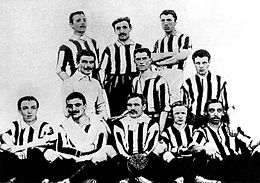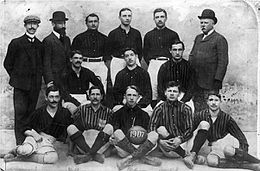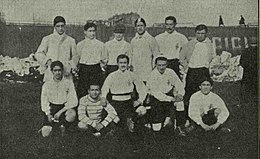In August 1909, the Federation's Annual General Meeting in Milan enacted a historic revolution in the league. Inspired by the British First Division's model, FIGC (the new name of the FIF) established a single group for the national title, canceling regional elimination rounds. The adopted formula was simple, with all the teams required to meet their opponents twice, once playing at home and once away. The result was a drastic increase in the number of matches and the start of the tournament in the autumn. Excluding the Veneto teams returning from unsuccessful performances, ten teams from the Industrial Triangle (Milan-Genoa-Turin) joined the championship, the eight from the two First and Second Category of the previous year with the addition of the Milanese Ausonia and the Torinese Piemonte, accepted by their encouraging results in the latest friendly matches.
A further decision made in the Federal General Meeting is the unification of the two tournaments, Federal and Italian, into a single national round, while continuing to award the two titles of Federal Champion, promoted after the past season to the absolute title of "Champion of Italy" and Italian Champion (for the teams lining up only national players), relegated instead to a "minor" title. According to Article 2 of the FIGC Championship Regulations promulgated in Milan on 8 August 1909.
The Championship
The first single-round tournament was characterized by a tight head-to-head between Internazionale and reigning champions Pro Vercelli, resolved by one of the most controversial outcomes in the history of Italian football. After a bad start, the Nerazzurri, now led by Ettore Strauss as a chairman and with a team chiefly made of Swiss players, strung together a record streak of eleven consecutive successes, but an unexpected defeat against Genoa on 3 April 1910 mathematically precluded the Internazionale from overtaking the Vercelli team (already sure winners of the secondary title of 'Italian champions') in the standings. On 10 April, Inter beat Torino 7-2 and tied Pro Vercelli at the top of the league table, making an additional game necessary for the assignment of the Federal title. Article 8 of the Federal Regulations, stated that the Club with the best goal quotient had the right to play the play-off at its field. Thus, the Piedmontese obtained the home ground for the tie-breaker game.

The controversy began when the Federation had to establish the date of the challenge: since on May 5th and May 8th preparatory matches were to be held for the Italian national team's debut on May 15th against France, it became necessary to play the play-off when there were still some championship matches delayed, even if those were now irrelevant. Therefore, only three Sundays remained available: April 17th, April 24th and May 1st.
The troubled road to the Tie-breaker
On April 10th, as soon as the play-off were certain, the Pro Vercelli president Luigi Bozino informed the FIGC of his opposition to the first two dates and requested the match on May 1st for organizational reasons: on the 17th several Pro Vercelli players were busy with a student competition organized by the Milan newspaper Il Secolo, while on the 24th a tournament between military teams was scheduled, also organized by Il Secolo, for which Pro Vercelli had to provide three players: Fresia, Felice Milano and Innocenti. The Piedmontese were also in talks with Ausonia to play a friendly match in Caresana on April 24th for the concurring patronal feast. Pro Vercelli received verbal assurances on the success of the request from the president of the Federation Luigi Bosisio (a Milan FCC founder and then one of the few secessionists remaining in Internazionale's management until the previous year, when he moved to Lambro FC), although the final decision regarding the date of the play-off was not up to him but to the Federal Council. Internazionale, however, manifested on 11 April its refusal to the double postponement of the match: The Nerazzurri pointed out that from May 1st they had to play a football tour in Tuscany and Emilia, and that many of their Swiss players, would have had work impediments. The situation turned out to be impasse.
The turning point in this impasse came on April 17th, when no Pro Vercelli players participated in the student tournament. The Federal Council suspected that the postponement of the play-off had been requested only to allow their elements a better rest and to recover some injured athletes and decided on April 19th to confirm the match for the 24th and to schedule for May 1st the possible repetition in case of a draw. A breaking news published by Foot-Ball, the FIGC's official magazine, three days before the fateful date, reported that some Pro executives, on a visit to Milan presumably to make "practices for the postponement of the match", had confirmed that a couple of players from Vercelli (Rampini and Corna) would be unavailable for health reasons.
President Bozino tried to bargain for the game on May 1st, with the concession of playing in Milan. Internazionale refused. Bozino then stood his ground and announced on April 23rd that he had decided, in protest, to field the youth team of eleven to fifteen-year-olds. Instead, on the pitch, the day after, Pro Vercelli presented a mixed squad of their available first-team players and reserves. The Nerazzurri, complying with the Federation's orders, played with the first team but were puzzled by the chaos.
On the stands, the Piedmontese fans and other Vercelli's unavailable first-team players jeered at Internazionale, still not managing to overcome the mixed mash team. The mess created by Bozino managed to save the Pro Vercelli from an announced defeat, with the game placidly stalling to an uneventful 3-3.
Carlo De Medici and Ettore Strauss, the new and former chairman of Internazionale protested heavily on Bozino's intrigues, but they were met with little support by the Federation and with extreme prejudice by the fans, especially from their former associates of Milan FCC and their opponents of USM, steadfastly a fully-Italian team, with Virgilio Fossati (a former Internazionale player) as a Captain. It was Fossati to furtherly stir the pot with a brief interview for Foot-Ball magazine: "Internazionale is a Swiss team with very few Milanese players, they should go play with Lugano and Servette, in my opinion."
In the repeat, held at Campo di Ripa Ticinese at Internazionale's grounds, Pro Vercelli presented its best team, with the defection of Corna only. Moreso, the majority of the stands were occupied by USM and Milan FCC supporters who actively encouraged the Piedmontese. At some point, the referee Goodley assigned a penalty to Internazionale on the result of 4-3 for Pro Vercelli. Ermanno Aebi, an Italian of Swiss descent, presented himself on the penalty spot, while the stands roared in whistles and chants against the "Swiss team". Aebi missed the chance, with Innocenti deflecting the shot on his left. Pro Vercelli won the repeat and became champion for the second time.
Italian Champions History:









